Mary Anne Yarde's Blog: The Coffee Pot Book Club , page 218
September 8, 2016
"We sell any monk..." ~ the appeal of Horrible Histories
“History can be horrible.”Horrible Histories
I'm sticking with "teaching our children history" theme this week, and I wanted to take a look at Horrible Histories by Terry Deary ~ you may have come across his work??! The Horrible Histories is a series of books looking at the…
“...wicked, weird and woeful…”
…history, that is aimed at children. They are history books in cartoon form. The first Horrible History was published in 1993, can you believe it. They have been with us for over 20 years!

Deary is a very opinionated author. He is very vocal on the state of education in Britain, and he is also rather critical of historians. This is what he has to say about the latter…
"…(Historian’s)…are nearly as seedy and devious as politicians..."
Ouch!
Deary started life as a drama teacher – well not literally, but you know what I mean. He was a Drama teacher, not a History teacher. But, Deary has, and there is no other way to say this, succeeded where others have failed. He has managed to engage children into loving history. He has made a career out of doing this.
The first thing you notice about his books are the titles. Here's a few examples…
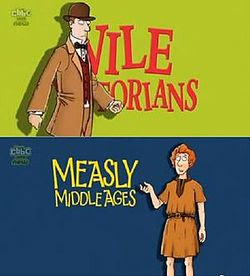
There is nothing as awesome as alliteration, is there?!
My children love Horrible Histories. They really really love it. I have lost count how many books we have, but it is definitely in double figures. I think Deary wrote somewhere in the region of 40 Horrible History books.
In 2009 the BBC picked up the books and made them into a very popular children’s program, which is still being aired today ~ We do have all the DVDs! I have taken my children to see the live shows several times. For the last couple of years, Horrible Histories have been guests at Warwick Castle for the summer holidays, and as we try to go to Warwick Castle every year because it truly is amazing ~ and if you haven't been you really should ~ we get to interact with the Horrible Histories actors. They are not only entertaining but they let children experience a Victorian School, or a Viking Camp and of course they let the children do lots of vile things!
Horrible Histories, however, has come under fire… The English journalist, Simon Hoggart, has this to say about the television show.."…where the books make a rudimentary attempt to teach history as a series of interconnected events, the television show is basically gags, chiefly about defecation, gluttony, murder and torture…”
David Horspool, historian, argues for Horrible Histories…
“…Getting children interested in the past isn't necessarily easy, and Horrible Histories does it extremely effectively—and those who come to history because it's fun seem far more likely to stay with it in the long run…"
Historian, Dan Snow, states that Horrible Histories is….
"…One step above Blackadder,”
But hey, Baldrick had a cunning plan and maybe Deary has too.
Snow then goes on to say…
“…it plays to stereotypes, but it's fantastic as entry-level history…”
I was talking in a past blog about how important it is to make teaching history enjoyable, and Horrible Histories does this through songs and dance. Of course, this does have disadvantages. Check this out short clip.
Horrible Histories Vicious Vikings,We Sell Any MonkI had to cope with some very strange looks while walking around the supermarket with my youngest, who had decided to sing the Horrible History song ~ "We Sell Any Monk," at the top of his voice ~ he would have made a good Viking.
For children, I think the Horrible Histories series is great, and if it gets them interested in history then surely that is a bonus?!
Published on September 08, 2016 00:00
September 7, 2016
Author’s Inspiration ~ Mercedes Rochelle #histfic @authorRochelle
Please give a warm welcome to historical fiction author, Mercedes Rochelle, to talk about her inspirations behind her book…The Sons of Godwin
 Earl Godwine had great plans for his children. But he didn't understand his sons. And they barely understood each other. This is England in the days of Edward the Confessor, when Godwine and his sons tower over the other great families. Harold emerges as the power behind the throne. Tostig rules the north. They control all the earldoms except one. What could go wrong? We see tumultuous events of the mid-11th c. through the eyes of Godwine's sons. Harold's story is all about Harold, but his brothers see things differently. Their remarks are tinged sometimes with admiration, sometimes with skepticism. Alas, Harold’s rise in fortune is not blameless and sometimes those closest to him must pay the price of his fame.
Earl Godwine had great plans for his children. But he didn't understand his sons. And they barely understood each other. This is England in the days of Edward the Confessor, when Godwine and his sons tower over the other great families. Harold emerges as the power behind the throne. Tostig rules the north. They control all the earldoms except one. What could go wrong? We see tumultuous events of the mid-11th c. through the eyes of Godwine's sons. Harold's story is all about Harold, but his brothers see things differently. Their remarks are tinged sometimes with admiration, sometimes with skepticism. Alas, Harold’s rise in fortune is not blameless and sometimes those closest to him must pay the price of his fame. TOSTIG AND HAROLD'S SIBLING RIVALRY
TOSTIG AND HAROLD'S SIBLING RIVALRY To this day, 950 years after the Norman Conquest, many of us are still fascinated by the causes of this pivotal event—and I am one of them. If Harold Godwineson hadn't been 260 miles away fighting his brother when Duke William landed at Pevensey, things might have gone differently. So where does Tostig come into this? From outlawry to Stamford Bridge, Tostig was on the wrong side of the law. In that critical battle, he seems to have been second in command after Harald Hardrada and has been branded as a traitor ever since.
It was thought by many that Tostig himself persuaded Hardrada to invade, thus forcing King Harold to rush north and defend his kingdom against the Vikings. However, this conclusion is by no means certain; nobody was tracing Tostig's movements in the early part of 1066. It's entirely possible that the Norwegian King planned the invasion on his own, and Tostig merely fell in with his army when the time came. There is no doubt that Hardrada was the leader of the Viking invasion. What exactly Tostig thought to accomplish is uncertain. Perhaps he only wanted his old earldom back. Or, he might have bargained to rule his old earldom as sub-king to Harald. Maybe he hoped Hardrada would get killed and he could rule in his stead, unlikely though that sounds.
But why was Tostig fighting against his brother, anyway? This was the question that inspired me to write THE SONS OF GODWINE and my upcoming FATAL RIVALRY. Why was he outlawed? How could Harold allow his brother to go off in such a rage that he would come back with an invading army? Surely Tostig had his reasons; such a devastating turn of events could have not come about arbitrarily.
In a situation like this, matters usually deteriorate over the course of time. Harold and Tostig were only a couple of years apart. Was there rivalry from their boyhood? Did Tostig feel left out? When Tostig became Earl of Northumbria, his brother had already been Earl (first of East Anglia and then of Wessex) for 10 years. What did Tostig do all that time? There was no catching up; by 1055 Harold was practically the "right hand" of King Edward, and frequently took on responsibilities that the king didn't want to be bothered with. When Tostig helped his brother during the Welsh campaign of 1063, what was his reward? Harold was lauded as a great warrior because of this campaign; Tostig barely received mention, and may well have emptied his coffers to help pay for it. Could this have contributed to the stress between them?
The real trouble started in 1065; up until then Tostig had ruled Northumbria for 10 years without any major disturbance. However, after the Welsh campaign he found himself obliged to impose new taxes on this previously undertaxed earldom. Some have said that Tostig needed to pay for the campaign. Other historians suggested he was urged to do so by Harold, acting in concert with the king who wanted to bring the north more in line with his southern provinces. There were some political assassinations that might have contributed to the unrest, but most historians agree that taxation issues pushed the troublesome thegns to revolt.
And what a revolt it was! Tostig was in the south hunting with King Edward when thegns from all over Yorkshire and Northumberland gathered in York and attacked the Earl's housecarls, catching them totally unprepared. Although Tostig's 200+ troops tried to fight back, they were unable to mount an organized defense and were killed almost to a man. The rampaging rebels broke into the armory, destroyed Tostig's manors, and raided the treasury, making off with all the carefully gathered taxes.
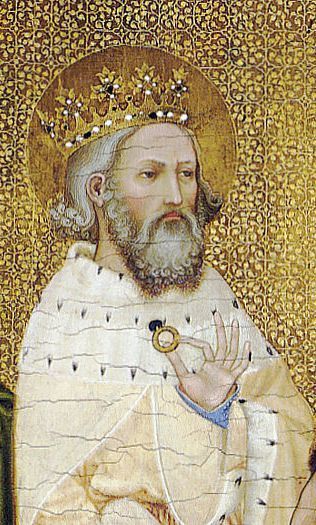
King EdwardNext on the agenda was to call a witan and elect a new Earl: Morcar, younger son of Earl Aelfgar of Mercia—who just happened to be standing by. This was a totally illegal move and the rebels knew it, so they proceeded to rampage their way south and force the issue with the king. Enter Harold, who was delegated to mediate for Tostig. King Edward and Tostig had every reason to believe Harold would get what they wanted, so they were more than horrified when their negotiator came back with rebels in tow. Morcar and his supporters didn't trust Harold and insisted that the king be confronted personally with all their demands. A second round of negotiations ensued, and Harold was still unable to budge the rampaging Northumbrians. They declared that Tostig had to go and that Morcar be officially declared Earl, or else they would continue their depredations into East Anglia.
Tostig went into a rage and accused Harold of fomenting the rebellion himself. In self-defense, Harold offered his sworn oath that he was not responsible but Tostig was having none of it. Edward wanted to raise the fyrd and teach his errant subjects a lesson, but the late season and poor support for Tostig's cause were enough to foil the king's empty threats. Edward eventually backed down and gave into the rebel demands, though the loss of royal prestige was a blow the king never recovered from. Just over a month later, King Edward was dead.
Tostig left the country voluntarily enough, loaded with gifts from the king but still swearing revenge against his brother. Apparently Harold washed his hands of the whole situation, for he is not recorded attempting to offer Tostig any compensation until the battle of Stamford Bridge. Even after he became king, Harold supported the wily sons of Aelfgar (his former rivals) and even married their sister to prove that Tostig was not coming back. Tostig may have found this doubly insulting. By the time they faced each other on the battlefield, Harold is said to have offered back the earldom if Tostig would lay down his arms. When Tostig asked what Harold was prepared to offer Hardrada, we hear the famous line "Seven feet of English ground, or as much more as he may be taller than other men." At this response, Tostig righteously refused his brother's offer. (I still find this episode a little implausible; it came from Snorri Sturluson, whose account may be somewhat apocryphal.)
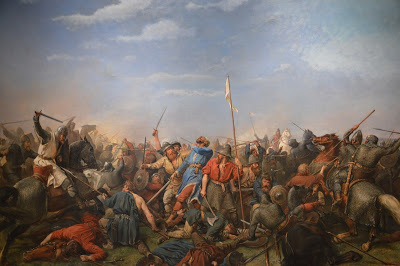
The Battle of Stamford BridgeSo his sense of betrayal was surely a driving force for Tostig's attempted return. But there is another factor to remember: there were plenty of precedents for an Earl to rampage his way back into favor. Earl Godwine did it in 1052, and Harold himself was part of that reunion; his bloody encounter at Porlock left behind 30 dead thegns and countless others. Even Aelfgar, Morcar's father, wreaked havoc on two occasions (the first causing the destruction of Hereford in 1055); both times he was restored to his earldom. So Tostig was just following suit; of course, his allies were a bit more powerful than Aelfgar's!
Purchase LinksAmazonB&N
About the author Born and raised in St. Louis MO, Mercedes Rochelle received a degree in English Literature from University of Missouri. She learned about living history as a re-enactor and has been enamored with historical fiction ever since. A move to New York to do research and two careers ensued, but writing fiction remains her primary vocation. She lives in Sergeantsville, NJ with her husband in a log home they had built themselves.
LINKS:Twitter: @authorRochelleWebsite: http://www.MercedesRochelle.comHistorical Britain Blog: http://mercedesrochelle.com/wordpress/Facebook: http://www.MercedesRochelle.net
Pictures: Battle of Stamford Bridge by Peter Nicolai Arbo, 1870 (Wikipieda) Edward the Confessor, Detail from the Wilton Diptych, National Gallery London (Wikimedia)
Published on September 07, 2016 00:00
September 6, 2016
I love history, but my school won't let me take it. #history #education
"I love history, but I am not very good at it, so the school won’t let me take it at GCSE."
I looked at this young person who was telling me about what subjects she was taking this coming term with my mouth wide open in disbelief. I didn’t know what to say, which for those who know me would come as a bit of surprise. What do you say to someone who has been told that they are not good enough to take a subject that they love?
This got me thinking about the old days ~ well my youth, but to my children, anything before 2000 is the old days! Most specifically I was thinking about my experience of learning History at school. Now, I was always a bit of a History geek, it was without a doubt my favourite subject, but I'll let you into a little secret that I kept hidden from my classmates ~ I wasn't very good at it.

My old School ~ yes, I know, a perfect example of what you can do with concrete blocks and glass.
Back in the day, when I was choosing which subjects I wanted to take for the relatively new GCSE syllabus, I put down History as my chosen Humanities subject. When the Head of the Department saw this, I was called into his office to see him. He had a very concerned look on his face, and he said to me, something along the lines of this...
"Mary, you put down GCSE History as your chosen Humanities subject?" He said it like a question rather than a fact.
"Yes," I answered, nervously, knowing what he was going to say, but silently willing him not to say it.
He sighed, and his face had a strained look upon it. "We have been discussing you in the department..."
And I thought, here we go. He is going to say no, you can’t take it.
"... You are a straight A student in Geography and Religious Education. We think it would be in your best interest to choose out of those two. So which one shall we put down?”
My personal choice would have been to take all three subjects, but that wasn't allowed. I would have happily dropped Maths ~ but they weren't having that!
"But," I answered. "I want to take History. I love History. I want to be a History Teacher."
He shook his head in despair. "You really need to think about this some more. I'll see you again in a couple of days."
A couple of days went by, and I found myself back in his office. Thankfully, this time, he saw how determined I was, and he made a decision to let me take the subject that I loved, against his better judgement.
I was very lucky I had two very switched on History teachers, who were not only incredibly amusing, but they genuinely wanted to see me succeed. They asked me what my goal was and then they went out of their way to give me as much guidance as possible to achieve that goal. I went from D/E History student to an A/B one. I passed History GCSE with flying colours. I took the subject to A’ Level and then on to University. Now who is to say, that this young person I spoke to just the other day, couldn't do the same?
My favourite all time teacher was one of my History teachers. I have never met anyone teach history the way he did. He was inspirational. I don't think I have ever laughed so much as I did in his lessons. He was incredibly entertaining ~ he once dressed up as a Garibaldi Biscuit ~ it was his interpretation of Giuseppe Garibaldi ~ yeah, I know, we didn’t get it either!
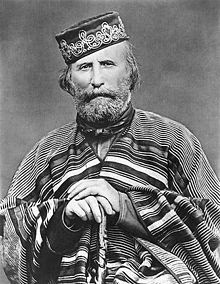 Giuseppe Garibaldi
Giuseppe Garibaldi
A Garibaldi Biscuit!
I can still remember what he taught me. But the thing that stands out most was his commitment to his pupils. He would go out of his way to help us. He would stay behind after school, if we needed extra help. We were never a burden to him. He obviously loved his job, and this came across in his teaching.
I wanted to go to Cardiff University to study History, but I screwed up my mock exam big time. I mean BIG TIME. I scarcely passed it. Cardiff wanted BBB, I wasn't too concerned about the other two subject I was taking, but I was hoping Cardiff was going to ask for a C in History ~ With a lot of work I might just pull that off. But after the disaster of the mock, I knew that there was no way I was going to get a B. I was upset, I thought this is it, this is where my dream ends. I had less than six months to pull it out of the hat. My teacher read the letter from the University and said, "Right. You need a B. Listen to me, do as I say, and I promise you, you will nail it." I listened. He tutored. And I nailed it. I got that B and I was offered a place at Cardiff University.

Cardiff Univeristy
My other History teacher was also a great man. He wasn't ashamed to shed tears when we were studying the extermination of the Jews in Nazi Germany. I came away from that lesson crying, as did many of my other classmates.
So when I hear that our young adults are being stopped from taking the subjects they love because of League Tables, it makes me very emotional. What if the Head of Humanities had said "NO" to me when I was 14? What if I had ended up taking Geography? I certainly would not have thrown myself into the subject the way I did History and even though I tutor Geography from time to time, History is still where my passion lies, and it always will be. When I am tutoring History, I feel alive, and I make sure that the children I tutor come away from the lesson with a smile on their face because I know from experience that they will remember what I said. And if I am tutoring a challenging aspect of history, I am not ashamed to let my eyes water.

For me, History was never boring, because the teachers didn't make it so and therein lies the key to bringing up a generation of history lovers. It isn't all about dates and boring facts. History is about people. People like you and I who, because of circumstances, find themselves doing the most extraordinary things. It is about the stories of our collective past and if our young people want to learn about it, who are we to say no, just because they may not get an A?
Published on September 06, 2016 00:00
September 5, 2016
New Release ~ The Keresa Headdress #Archaeology #crime @larrydshack
It is with the greatest pleasure that I welcome back one of my favourite authors onto the blog to showcase the re-release of one of his fabulous books…
The Keresa HeaddressByLarry Shackelford
 It’s just a routine case at the FBI’s Salt Lake City offices. The young woman’s boyfriend is missing, possibly dead. Agent Karen Adams thinks he’s probably just out with another woman—but then the Royal Canadian Mounted Police come calling. Why would they care about a wayward addict cheating on his girlfriend in Utah? Soon, Karen is involved in a case like nothing she’s ever seen, navigating through an international criminal network of drugs, sex trafficking, murder, and the black market trade of priceless archaeological relics. Her new partner Marcus “Playboy” McCoy—handsome, charming, and almost unbearably crass—is equal parts help and hindrance as she navigates a seamy underworld in the Utah desert. But she also finds assistance from some unusual sources: a graduate student in archaeology, a dissatisfied sister-wife from a polygamous commune, and an undercover Canadian Mountie. Together they become entangled in the web of international crime and the only way out is to find the most priceless artifact of all: the legendary Keresa Headdress.
It’s just a routine case at the FBI’s Salt Lake City offices. The young woman’s boyfriend is missing, possibly dead. Agent Karen Adams thinks he’s probably just out with another woman—but then the Royal Canadian Mounted Police come calling. Why would they care about a wayward addict cheating on his girlfriend in Utah? Soon, Karen is involved in a case like nothing she’s ever seen, navigating through an international criminal network of drugs, sex trafficking, murder, and the black market trade of priceless archaeological relics. Her new partner Marcus “Playboy” McCoy—handsome, charming, and almost unbearably crass—is equal parts help and hindrance as she navigates a seamy underworld in the Utah desert. But she also finds assistance from some unusual sources: a graduate student in archaeology, a dissatisfied sister-wife from a polygamous commune, and an undercover Canadian Mountie. Together they become entangled in the web of international crime and the only way out is to find the most priceless artifact of all: the legendary Keresa Headdress. Book Extract
“We’re getting close!” Tommy said enthusiastically as he bent down and picked up a hand-chipped piece of red chert that had been formed into a straight, sturdy point. Admiring the ancient stone, Tommy gently turned the piece in his hand under a flashlight, marveling at the intricate contours. “Now that’s a pretty nice awl somebody made about a thousand years ago, probably used for sewing pieces of leather together,” he declared with a pronounced lisp. “Tommy, we don’t have time to collect every little piece of history! Wendy is expecting us back this afternoon, so let’s hurry up and get to the granary. Locomotive Rock is very close and I want to collect the good stuff and get out of here before daybreak.” Jimmy scolded.Tommy carefully placed the awl in his left front pant pocket and continued walking through the thick green juniper trees and the deep cheatgrass. He beamed with excitement when he and Jimmy finally broke into a clearing and spotted the massive landmark. Locomotive Rock was a series of sandstone formations that looked exactly like a locomotive.“Another hundred yards and we hit pay dirt. It’s easy money, man, easy money in the bank, and a lot easier than moving meth.” Jimmy and Tommy quickened their pace through a cattle trail as their hearts raced with the anticipation of discovering their pending prize: an undisturbed, pristine, archeological treasure. Overjoyed with the idea that they were soon going to be rich, neither of the young men was aware that two other men were shadowing them in the stillness of the night. The dim moonlight illuminated the cloud-covered sky, and made it easy for the men to conceal their pursuit of the hopeful pothunters. Silently hidden behind the dense pinyon pine and juniper brush that covered Utah’s remote central mountains, the stalkers silently waited for their opportunity. Jimmy and Tommy were close—less than fifteen feet away. Almost close enough to reach out and grab. A few more steps…the killers silently sprang from their positions and thrust steel blades into the backs of the unsuspecting pothunters. Jimmy and Tommy died without their treasure. Their dreams died with them. That night, someone else entered the coveted caverns surrounding Locomotive Rock.
Purchase LinksAmazon USAmazon UK
I am pleased to announce that Mr. Shackelford will release the exciting sequel to this book in a few months. The sequel is entitled…
The Keresa Headdress II The Reliquary
After reading the description below, I can't wait to read it!
The Reliquary is the sequel to The Keresa Headdress. The fast-paced crime fiction novel takes place in Salt Lake City, Utah. The unique cast of characters from the Keresa Headdress are back, along with new team members, to solve another extraordinary criminal investigation involving fossil theft and a psychotic killer. FBI Special Agent Karen Adams' career has flat lined since the exciting Keresa Headdress investigation, where she met Special Agent Marcus "Playboy" McCoy and her fiancé, archaeologist Derek Simms. Karen's supervisor, Roger Miller has since reassigned her to investigating mundane medical waste, fraud and abuse cases. Karen and Marcus are reunited as unlikely partners when a paleontology team goes missing in the remote Morrison Formation near Richfield, Utah. The missing persons case quickly escalates into a chilling nightmare that no-one could have expected. Karen and Marcus soon discover the murdered scientists along with missing Allosaurus fossils. The violent killer leaves few leads to pursue, and the team enlists Riley, a local polygamist and nudist, along with heavyset homicide detective, Colin Childs, to assist with the investigation. Marcus continues his “Playboy McCoy” antics until he meets Dr. Lisa Gruber, a paleontologist from the University of Utah who is unlike any woman he has ever met. Dealing with recent personal issues, Karen finds herself in another professional frustrating situation. Unfortunately, she must risk her own life as another case submerges her into the unimaginable underworld of antiquities theft and the criminally insane.
About the author
 Larry was raised in southwest Missouri where he received his college degree, but he received his education after he graduated and began working in a maximum-security federal prison. After spending two years behind bars, he continued his law enforcement career as a criminal investigator, residing and working in eight states and two foreign countries. Larry retired from law enforcement after twenty-five years of service and resides in Salt Lake City with his wife and cat.
Larry was raised in southwest Missouri where he received his college degree, but he received his education after he graduated and began working in a maximum-security federal prison. After spending two years behind bars, he continued his law enforcement career as a criminal investigator, residing and working in eight states and two foreign countries. Larry retired from law enforcement after twenty-five years of service and resides in Salt Lake City with his wife and cat.
Published on September 05, 2016 08:27
September 1, 2016
My search for Robin Hood continues... #Legends #Sherwood #RobinHood
Robin: "If we kill Gisborne in cold blood, then we'd be no better than he is."
Will: "Well, what makes you think we are?"
Robin of Sherwood.
The world in which Robin Hood lived was far from the romantic version that we have in our heads. Everyone wants a hero; I understand that. And we need a champion for the poor. Robin is the emblem of that. He is all about helping people and fighting injustice. He is a role-model we need him, even, no especially, in this day and age.
But what if he wasn't as good as we want him to be?
In the early ballads of Robin Hood, Robin doesn't come across as a champion of the people and neither do his men. They are not particularly merry and forget about the Lincoln Green and the tights…where are the tights? I am so disappointed!

Firstly, let's not forget that Robin was an outlaw. Of course, he may have been an innocent, wrongly convicted. Or maybe, dare I suggest, he had done something criminal? We don't know why he or his men became outlaws. They just are.
I had mentioned the Wakeford Hoods before ~ was this the origins of Robin? Again, it is all speculation. This family certainly had an interesting history with the law, but where is the proof?
In the 1930's there was a fascinating discovery. In the court roll of the Archbishop of York, dated 25th July 1225, there is a rather interesting entry. One Robert Hood was fined 32s.6d. Such a fine would suggest that Robert was not a poor man. The next year his name appears again, but now he is being called Hobbehod (the Devil-Hood). Could this be the man we have been looking for? Was this the start of the "Hobbe the Robber" legend?
Unfortunately, we know nothing more about him, only that he fled justice and earned the title of outlaw.
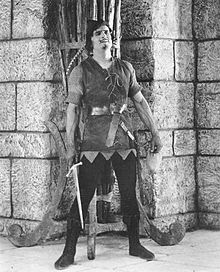
Douglas Fairbanks as Robin Hood
What happened next was interesting. His name became a nom de plume. Let's take a look at the 1331 Act of Parliament.
"...robberies homicides and felonies done in these times by people called Roberdesmen..."
These are Robert's men ~ his merry men. It's a shame they were operating 100 years after he did!

By 1381 "Hobbe the robber," becomes a folk name. Robin Hood, the historical man, becomes Robin Hood the legend.
"So as it stands, the only serious candidate so far for a real-life Robin is the northern outlaw Robin Hood in 1225."
Michael Wood ~ In Search Of England.
So there we have it. We have a contender.
Published on September 01, 2016 00:00
August 31, 2016
Author’s Inspiration ~ Elisabeth Storrs #histfic @elisabethstorrs
I am so excited to have historical fiction author, Elisabeth Storrs on the blog today to tell us about her inspirations behind her latest book…
Call To Juno
 "An elegant, impeccably researched exploration of early Rome and their lesser known enemies, the Etruscans… Elisabeth Storrs weaves a wonderful tale!" Kate Quinn, author of The Empress of Rome Saga
"An elegant, impeccably researched exploration of early Rome and their lesser known enemies, the Etruscans… Elisabeth Storrs weaves a wonderful tale!" Kate Quinn, author of The Empress of Rome SagaFour unforgettable characters are tested during a war between Rome and Etruscan Veii.
Caecilia has long been torn between her birthplace of Rome and her adopted city of Veii. Yet faced with mounting danger to her husband, children, and Etruscan freedoms, will her call to destroy Rome succeed?
Pinna has clawed her way from prostitute to the concubine of the Roman general Camillus. Deeply in love, can she exert her own power to survive the threat of exposure by those who know her sordid past?
Semni, a servant, seeks forgiveness for a past betrayal. Will she redeem herself so she can marry the man she loves?
Marcus, a Roman tribune, is tormented by unrequited love for another soldier. Can he find strength to choose between his cousin Caecilia and his fidelity to Rome?
Who will overcome the treachery of mortals and gods?***
 There would be few people who haven’t heard of the famous siege of Troy. The exploits of the heroic Achilles, Hector, Agamemnon and Menelaus have been retold for thousands of years. So too the infamy of Helen and Paris, the lovers who sparked the war.
There would be few people who haven’t heard of the famous siege of Troy. The exploits of the heroic Achilles, Hector, Agamemnon and Menelaus have been retold for thousands of years. So too the infamy of Helen and Paris, the lovers who sparked the war.However, there was another siege that lasted a decade. A conflict known only to those who are aware of an obscure episode in Roman history. It was a war fought between Rome and the Etruscan city of Veii. However, unlike the Greeks who sailed over the sea to battle the Trojans, the Romans only ventured twelve miles across the Tiber River to attack the Veientanes. Yet despite being close neighbours, the enemies were from opposing worlds so different were their customs and beliefs. For the nascent Republican Rome was austere and insular compared to the sophisticated Etruscans with their vast trading empire. And while Roman women were second class citizens, Etruscan women were granted independence, education and sexual freedom.
My interest in these contrasting civilisations was piqued more than 15 years ago when I discovered a photo of a 6th century BC sarcophagus depicting a life size couple embracing on their bed. The casket was unusual for that period because women were not usually commemorated in funerary art. Discovering more about the ancient society that portrayed such tender affection led me to the world of the Etruscans and the Tales of Ancient Rome.
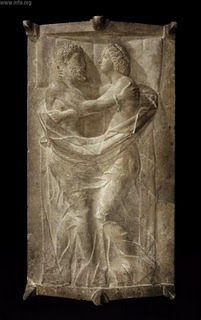
As in the Iliad, the fates of the characters in my saga are entwined around those of two lovers who are blamed for starting the war: the Roman treaty bride, Caecilia, who comes to love an enemy nobleman, Vel Mastarna, whom she is forced to marry in The Wedding Shroud . Ultimately Caecilia must determine where her loyalties lie: her birthplace or her husband’s city. Yet her decision to forsake Rome in The Golden Dice means she is perceived as an enemy by the Veientanes while knowing that, if Veii should fall, the Romans would execute her as a traitoress. In Call to Juno , Caecilia must summon even greater reserves of strength at the height of the siege to prove her loyalty to Mastarna’s people, and ensure the survival of her family.
The Golden Dice and Call to Juno continue Caecilia’s journey which begins in The Wedding Shroud but I’m sure readers will have no problem in following the plot whichever book they pick up first as I wrote each as a standalone novel. And to ensure both sides of the war are recounted, I introduced Pinna, a Roman tomb whore, into The Golden Dice. She is reduced to using coercion to escape her grim life but in the process falls in love with the Roman general who is besieging Veii. By following Caecilia and Pinna’s tales, the reader will not only learn about the battles fought between the warriors they love, but also understand the trials these women face in order to protect themselves and all those dear to them. Who will survive the treachery of mortals and gods?
Links to Purchase
 Amazon TheWedding Shroud The Golden Dice Call to Juno
Amazon TheWedding Shroud The Golden Dice Call to JunoAbout the author Elisabeth Storrs has long had a passion for the history, myths and legends of the ancient world. She graduated from University of Sydney in Arts Law, having studied Classics. Elisabeth lives with her husband and two sons in Sydney, Australia, and over the years has worked as a solicitor, corporate lawyer and corporate governance consultant. She is one of the co-founders of the Historical Novel Society Australasia.
Feel free to connect with Elisabeth through herwebsite or Triclinium blog. You can find her on Facebook, Twitter @elisabethstorrs, Bookbub and Pinterest. Subscribe to her monthly Inspiration newsletter for inspirational interviews and insights into history - both trivia and the serious stuff! You’ll receive a free 80 page short story, Dying for Rome: Lucretia’s Tale.
Published on August 31, 2016 00:00
August 30, 2016
Castle Dore and #Arthurian Legend #Cornwall
As you may know, I write historical fantasy set a generation after the fall of King Arthur. In The Du Lac Chronicles, my protagonist, Alden du Lac is the defeated King of Cerniw and his fort, called Castle Dore, has been razed to the ground. In The Pitchfork Rebellion, Alden sees first hand what the King of Wessex has done to his beloved fort. I want to have a look at the legend and the archaeological evidence of Castle Dore today.

Let's start with the legend.
Castle Dore was the home of King Mark of Cornwall and was the setting for one of the most beautifully tragic love story of all times. I am of course talking about Tristan and Iseult. Move over Romeo and Juliet you have nothing on these guys. If you want a recap on the legend, then check out the blog post I wrote on Sir Tristan. Now, on to the facts.
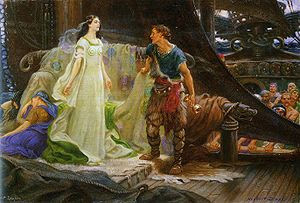
Tristan and Iseult as depicted by Herbert Draper (1863–1920)
What do we know of Castle Dore?
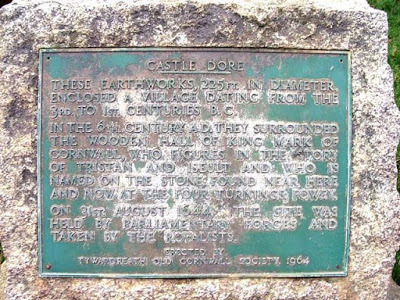
Castle Dore is situated just outside of Fowey in Cornwall. It is an Iron Age Hill Fort ~ I know I know, not quite the Dark Age fort that we want, but hey, when you are talking about legends what's 1000 years between friends?!
There is some speculation that the name Castel Dore comes from the Cornish "Earth Castle," which has an appealing ring to it, doesn't it?
Excavations were carried out on the site in 1936 and 1937 by the famed, Dark Age, English archaeologist and historian Courtenay Arthur Ralegh Radford (1900-1999). He concluded that the fort was re-occupied in the 5th/6th Century, which would tie in nicely with the Arthurian legend. Just to note, Radford also excavated sites at Tintagel and Glastonbury Abbey as well. But later interpretation of the site suggests that it was an Iron Age fortification, with little of evidence of Dark Age occupation.
However...The fort was re-occupied in 1644 by the Earl of Essex and his Parliamentarian Army during the English Civil War. To cut a long story short, the Royalist surrounded Dore. Essex managed to escape although there was a great loss of life. It was a bitter blow to the Roundhead's and ultimately secured the South West for the king, until the final days of the war.
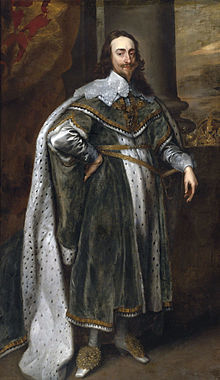 King Charles I
King Charles IThere is also evidence of a small village to the eastern gate of the Hillfort and in my books, Dore does have such a village.
I wonder why Dore was chosen to be part of the Arthurian story. It is small and seemingly insignificant and is now being left to crumble away. But whatever the reason, Dor is associated with the legend and I have to admit, there is something special about the place.
And if you fancy checking out The Du Lac Chronicles, you can find the link below.
Published on August 30, 2016 00:00
August 29, 2016
#bookreview ~ Smoke and Mirrors #YA #fantasy @Jess_Haines
Because sometimes a girl needs a dragon, not a knight.
Smoke and MirrorsByJess Haines
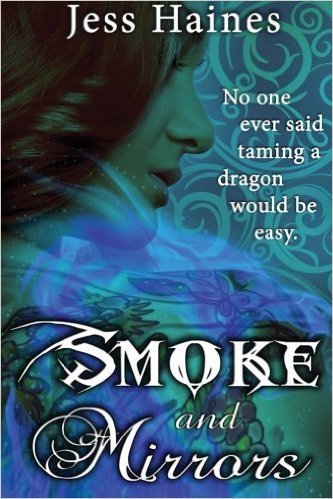
A girl who uses her illusions to fool the world into thinking she's just like all the other magi.
A dragon who sees through her lies.
Together they just might survive a world that wants to control or destroy them both.
Kimberly may wield ultimate cosmic power, but even a mage has to pay the rent. No one will hire her for her magic talents until she's got the credentials, so she's stuck in a crappy rent controlled apartment with her mother, yearning for treats she can't afford at her part time job in a cafe, counting down the days until she graduates the secret Blackhollow Academy school for magi. Only then will she have the certificate she needs to land her dream job in a coven.
The problem? She needs a familiar to graduate.
As an illusionist, she doesn't have the ability to summon or create a familiar of her own. Her only option is to convince a supernatural creature to let her bind it instead. Since having a powerful Other at her beck and call would guarantee her a place in a coven after she graduates—and legendary treasure hoards are an added bonus—she thinks binding a dragon as her familiar will solve all her problems...
*** My thoughts on the book…
Smoke and Mirrors ~ was ever a book so aptly named?
A skilfully told story that captured my attention from the beginning and held it throughout. This is an action-packed adventure, with so many twists and turns that it left me with whiplash ~ but in a good way!!
The protagonist, Kimberly, is an incredibly well-crafted character. She is one paycheck away from eviction, but she hides her hardships behind an illusion. No one sees the tatty clothes or how thin she is from lack of food. All her classmates see is someone who doesn’t quite fit into the magical world.Kimberly is desperate to graduate. If she doesn’t, then she fears that there will be no way out of the poverty that currently defines her life. All she has to do is find a dragon that will consent to be her familiar. But, what dragon would want to bond with someone like her?
I really liked Kimberly. She is a very loving and humble young lady, who doesn't come from a magical background ~ she only learnt that she had magic when she was 16 ~ because of this, Kimberly is sublimely unaware of the danger she is in. She seeks out Cormac, having no idea who he really is. She has been told that he can help her find a dragon. He is, therefore, her last hope.
Kimberly provokes strong protective emotions in Cormac, although at first, he is wary of her motives. Cormac cannot deny the physic desire he feels towards her and he cannot understand why he has this all-consuming, irrational want, to become her familiar.
I loved the characterisation of Cormac. He comes across as being incredibly wise and strong. You would want him in your corner! But there is also this endearing hint of vulnerability about him, which made him appealing. I enjoyed reading about him.
The antagonist, Viper, is a dark and poisonous character. He is suitably evil, although I am guessing there is a backstory to him, which I would be interested in learning about.
Smokes and Mirrors is a well-crafted and incredibly compelling novel. I loved the many mythical creatures. Haines has created a believable world with an endearing protagonist. A book worth reading.
I Highly Recommend.
Links to purchaseAmazon USAmazon UK
About the author
 I'm a displaced New Yorker with a penchant for the silly, the obscure, and the fantastical. Tampa, Florida is home for the time being. I'm currently working on the H&W Investigations urban fantasy series and the Blackhollow Academy young adult contemporary fantasy series. Find out more about my books, drop me a line, or join my mailing list at www.jesshaines.com!
I'm a displaced New Yorker with a penchant for the silly, the obscure, and the fantastical. Tampa, Florida is home for the time being. I'm currently working on the H&W Investigations urban fantasy series and the Blackhollow Academy young adult contemporary fantasy series. Find out more about my books, drop me a line, or join my mailing list at www.jesshaines.com!
Published on August 29, 2016 00:00
August 25, 2016
St Govan's Chapel ~ the final resting place of Sir Gawain? #Wales
Let me tell you a story...
There was once an Irish monk named Govan, who was travelling to Wales to visit family. The journey was uneventful until he reached Pembrokeshire. Here he was set upon by pirates. All hope was lost, until the cliff opened up and left a fissure just big enough for him to crawl into. Legend states that the cliff then folded itself around him, keeping Govan hidden from his pursuers. How fabulous is that?
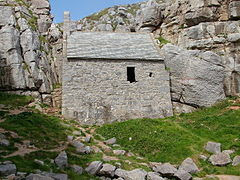
But hold your horses, there is more...
 So grateful was Govan for such divine intervention, that he decided that this was the perfect place for a hermitage.
So grateful was Govan for such divine intervention, that he decided that this was the perfect place for a hermitage.Now, Govan built his little chapel and he had a beautiful little bell. All was right with the world. Alas, those pirates came one night and stole the bell. Disaster.
But fear not, for the divine would intervene again. Some Angel's came down from Heaven and stole the bell back…
I don't know why that bit of the legend appeals to me so much, but it does.Turn in next week for another exciting episode of,
Angels v. Pirates.
Who will win?!...
Obviously, the Angels won and they gave the bell back to Govan.
But what was to the stop the pirates coming back and stealing the bell again?
The Angels came up with a cunning plan. If they were to encase the bell into a huge stone, then no one, not even those pirates, would be able to steal it again. Clever!
Now, I know what you are thinking. How can you peal a bell when it is encased in stone? For Govan, this was surprisingly easy, and boy did he make that bell ring. I don't know how just take my word for it.

But that is not all. There is more. The legend states that you can still see Govan's handprints on the floor of the cave, and it is reputed that he is buried under the chapels alter. And for many years if you wanted your wishes to come true then this is where you should go to ask them.
But...we aren't interested in that version of history. Hell, no. We want to hear the Arthurian one.
Okey-dokey. Right. Now stretch your imagination a little. Govan ~ sounds a bit like Gawain, or vice-versa. Is Govan actually a corruption of Gawain? Who knows!
Gawain will fit. He will be associated with this chapel. One way or the other. So here goes...

We all know the story of how Lancelot killed Gawain's brothers in his bid to rescue Guinevere from the pyre and how Gawain travelled to Brittany to seek his revenge. Lancelot didn't want to fight him, but Gawain wouldn't back down. Lancelot accidently kills him in a duel etc…etc...
Ah, but wait. In this story, Gawain doesn't die by Lancelot's hands. Oh no. When Arthur dies, Gawain, like many other knights, decides to live a life of simplicity and peace. He travels all the way to Pembrokeshire in Wales and he becomes a hermit. He builds a chapel, and this is where he spends the rest of his days. Gawain is even buried under the chapel's alter.
See, we can make him fit.
I have to be honest; I love both versions of the legend. It is just perfect. Much like that little chapel.
Published on August 25, 2016 00:00
August 24, 2016
Author’s Inspiration ~ Michael Reuel #history & #folklore @MichaelReuel
I am so excited to have Michael Reuel on the blog. His new book is definitely one I look forward to reading as it is all about Robin Hood!
Robin Hood ExistedByMichael Reuel

Historians tend to point out that there is no historical evidence for the existence of Robin Hood, but there is an incredible amount of folkloric evidence for his existence that has gone overlooked.
Folklorist Michael Reuel delves into the legend in order to assess how much we can learn by studying folklore, without applying the rigid terms of ‘historical’ proof. In the process he discovers that, although folklore does have obvious limitations in terms of what it can prove, the sheer amount of source material on Robin Hood is nevertheless sufficient enough to conclude that the famous outlaw and his Merry Men did in fact exist.
If you are interested to understand how Reuel has been able to arrive at this conclusion, then his research is chronicled here in the ground-breaking ‘Robin Hood Existed’; a study that promises to open a new window upon the story of Robin Hood and the life of thirteenth to fourteenth-century England.
As well as shedding new light upon the story of everyone’s favorite outlaw, Reuel provides a compelling exploration of the nature of storytelling, defining some of the key differences between how truth and myth manifest in the human psyche, and highlighting many factors that lead to certain peoples and stories becoming overlooked or dismissed by historians.
***
 A few years back the opening line of Wikipedia’s ‘Robin Hood’ page kicked off with a sentence that was something like, ‘Robin Hood was a medieval outlaw who didn’t exist’.
A few years back the opening line of Wikipedia’s ‘Robin Hood’ page kicked off with a sentence that was something like, ‘Robin Hood was a medieval outlaw who didn’t exist’.I don’t have the exact wording as the page has since been improved on, but I remember the line well because it was the catalyst for leading me to begin the research for what I then didn’t know would end up turning into the upcoming publication ‘Robin Hood Existed’. From the title, I’m sure it’s pretty easy to guess that my conclusions disagree with whomever was responsible for that Wikipedia entry. An amended page was not enough for my liking, however. My instincts had always been to suppose there was a real person behind the legend, but I had turned a corner and wanted something of substance to explain why.
For someone in love with British folklore I was conscious of the fact that the journey might be perilous, leading only to disappointment. What if I ended up siding with the naysayers? But that was not the case. The more I looked at all the factors involved the more complete my picture of the legend became, so much so that I don’t even like using the word ‘legend’ anymore and have tried to purge it from the book as much as possible.
Before stumbling upon Wikipedia that day I had always interpreted the public mood towards the Robin Hood story as being one on which the jury is still out. Although I sided firmly with the camp that thought he did exist, even before my own research, I was comfortable with the status quo; there is no firm ‘historical’ evidence after all. Fearing that there might be a growing tendency to dismiss England’s – and perhaps the world’s – favourite hero in such a way, however, made me sensitive on the subject of credibility. I began to notice how those who don’t believe that certain folklore has some truth behind it are far readier to adopt a tone of being in the right than those who remain curious. But baseless scepticism has never equalled wisdom, any more than romanticism has. Plus, as anyone who enjoys reading up on their favourite period of history will attest, the picture of history that the public consciousness is presented with – even to the extent of being taught it in school – is very rarely one from which sound judgements can be made.
Before I started reading up on Robin Hood’s time, the period of history I was most familiar with, from personal interest, was that surrounding the Norman Conquest of England. Now anyone who knows anything about British history knows that 1066 is a pretty important date to consider. People who grew up in the UK do not have to be very historically aware to know who the winners and losers were at the Battle of Hastings. Even those who try to avoid history as an interest are likely to be able to say something about King Harold being the one who possibly died with an arrow embedded in his eye.
On the famous demise of England’s last Anglo-Saxon king, however, I feel it apt to point out that I have yet to come across any major historical publication, in the last 20 years at least, that has found reason to humour the conclusion that Harold II died with an arrow in the eye or chopped down by a horse rider, as the Bayeaux Tapestry suggests.
Yet, presumably for no other reason than because this is a debate that has rumbled on through history and so has become a force of habit, we are still taught that this is what happened. Certainly I was taught so at school and, as I have worked as a proofreader of educational material, I have also come across the same teachings in current school texts. Along with many other statements that are simply amazing, such as ‘England as a nation was formed in 1066’.
It was not and neither did those responsible for the Bayeaux Tapestry know how Harold II died. Everyone who has written on the events of 1066 knows this, as does everyone who has read up on the up-to-date conclusions available, but everyone else still gets the other version.
Similarly, ‘everyone else’ is still presented with a construct of the Robin Hood stories that has the outlaw motivated by keeping the throne of England from Prince John, during the time when Richard the Lionheart was at war in the Crusades. Whereas those who have researched the original stories know that the king on the throne during Robin Hood’s time was always an Edward.
They should also know that the outlaw was a ‘yeoman’, which in aristocratic terms basically means a nobody. And yet many who do humour the possibility that the folklore is genuine still attempt to layer its origins with the idea that ‘Robin Hood’ became a second identity for some nobleman or earl with a grudge. The Earl of Huntingdon becomes a regular suspect, as does a disinherited Robin of Loxley.
Understanding why historians have constantly attempted to tie the outlaw to an identity that can be traced within available records became an important part of my research. A folklorist needs to understand what smokescreens have been put up and why, before being able to assess what the purist interpretation of the story really is and the truth that is too often overlooked when studying Robin Hood is that the life and achievements of yeoman from the thirteenth or fourteenth centuries are not very likely to be historically proven at all.
So why are we so unable to appreciate the down-to-earth side of this famous hero? Can it be that our modern sentiments still remain more attached to the glory of royal blood and nobility than we would like to think? For sure these desperate attempts to give a man who lived in the woods some kind of link to the aristocracy suggest so.
A scene from the film Monty Python and the Holy Grail springs to mind. King Arthur, on his way to a castle occupied by ‘French types’, stops to speak to couple of peasant folk who are rolling around in the muck. Prior to this he has been identified as a king by the commoners because ‘he hasn’t got shit all over him’. The peasant folk he stops to speak to are not so interested in him as Mary Anne Yarde, as one of them says ‘Dennis, there’s some lovely filth down here’, which they then start gathering. With this image in mind, I can’t help feel that all the historical studies available have done very little to advance our view of what common medieval folk were like. The peasants are more than they seem though, questioning the king’s right to rule supremely over them because some ‘watery tart threw a sword at you’ and lecturing him about how they are an ‘anarcho-syndicalist commune’.
It would be nice to think that an exchange like this did actually happen, but I feel it is also apt to question whether we really went through the entire medieval period without there being a single peasant or yeoman who turned out to be a lot more than meets the eye.
My research for ‘Robin Hood Existed’ is not solely a historical one, therefore, but also a folkloric one. The search demanded that I discard looking for proof of the outlaw in stately homes and official records and go deeper. Crucial to understanding the folklore is a better appreciation of what it meant to be a ‘man of the wood’, other than just that a woods is a convenient place for hiding from the Sheriff. The social heritage and geography of the region are essential in this respect, as are linguistic observations and, perhaps most importantly, the nature of storytelling itself, in both its written and oral forms.
Tread carefully, therefore. I promise to delve into the ‘legend’ without the need to tie up the folklore with recognised figures from history, or tying up the goings on in Sherwood and Barnsdale as having much to do with who sat on the throne of England at all. There will be no further layering or smokescreening in order to arrive at a position of comfort. So, if it does turn out that our favourite outlaw had shit all over him, then that’s just fine with me.
Purchase LinksKobo B&N
About the author
Michael Reuel is a writer of adventure mysteries that are inspired by myth, as well as being a keen folklorist. He grew up in Coventry, England and studied at the University of Wales, Bangor. His first published work was the sinister Not Far From Aviemore in 2014 and he is currently working on a follow-up, as well as exploring obscure pre-1066 folklore.
Published on August 24, 2016 00:00
The Coffee Pot Book Club
The Coffee Pot Book Club (formally Myths, Legends, Books, and Coffee Pots) was founded in 2015. Our goal was to create a platform that would help Historical Fiction, Historical Romance and Historical
The Coffee Pot Book Club (formally Myths, Legends, Books, and Coffee Pots) was founded in 2015. Our goal was to create a platform that would help Historical Fiction, Historical Romance and Historical Fantasy authors promote their books and find that sometimes elusive audience. The Coffee Pot Book Club soon became the place for readers to meet new authors (both traditionally published and independently) and discover their fabulous books.
...more
...more
- Mary Anne Yarde's profile
- 159 followers



